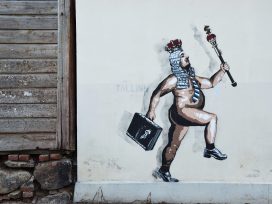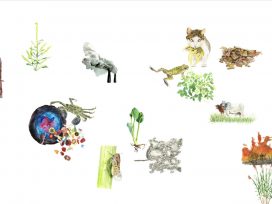The current phase of globalization is marked by an unprecedented distribution and condensation of cultural, political and economic networks; everyone would agree to that. There is nothing but disagreement, however. In view of the fact that this phase – which began between the 1960s and the 1980s – operates for the first time in history under the name “globalization” and thus embodies a battlefield of definitions, where not only the afore-mentioned networks need to be put into relation, but where the larger context as such, as well as its relationship with the other phases of the earth’s shrinking process, it needs to be defined. In that respect, the current phase of globalization is marked by a crisis of context. It is manifest through both a grave surplus and a lack of context, as can be seen for instance from the overbearing amount of conspiracy theories or their beginnings.
In the course of this crisis, central notions of order that draw on a whole (and thus a reason and a meaning) undergo a fundamental new identification. This is also true for what is possibly the most fundamental of all ideas of order: the community as experience, the category of relations, and the interpretational basis of the human experience. Against this background, the usual speech about the weakening or strengthening of the community in the context of globalization does not obtrude. Rather, the confrontation with globalization moves a complex change of relations and ties, affiliation and cohesion to the fore and thus, last but not least, comes the presentability of a community.
In a world where the eyes of the news, information, security and surveillance agencies capture and present everything, a world where transparency and visibility increasingly make up reality, more complex relationships become less transparent and more invisible. Accordingly, most of a community’s images reflect not as much the mere experience of being together as they do the powers that influence this experience, that monopolize and instrumentalize it. Are there any other depictions of the community? Are there forms of community that elude the usual mechanisms of depiction? These two different questions are linked because alternative forms of community: are they really imaginable without alternative descriptions? And vice versa: are descriptions that elude the usual mechanisms of political symbolizations without subversive constitutions of community imaginable?
Political imagination of threat
If you wonder what the state of a community’s depictability is like, you automatically raise the question of whether it in fact cannot be depicted at all. That moves into the limelight the “common ground of all strangers, refugees, homeless, immigrants and asylum-seekers”, in short: the common ground of all those who are left out – people whom Joseph Vogl grants political as well as emancipatory potential in view of the domineering “us”-imagery of the 1990s. Following the deeply symbolic fall of the Berlin Wall in 1989 and the ensuing climate of neo-nationalism, the images of people who are excluded can be seen as a counter model which is “less crystallized around a common good, a universal consensus and an unalienable status quo than around the exact list of breaks, losses and damaged spots”. The political imagination has yet to come up with images befitting this “constitutive incompleteness”, as Vogl called it 15 years ago. In the meantime, however, the deputies of this void – the excluded – have acquired a secure place in the mass media’s visual culture. And it seems as if the political imagination has once again been overtaken and undercut by the market’s semiotic packaging industry. However, the increased presence in news shows, political clips and comics of the excluded doesn’t automatically go hand in hand with the strengthening of their cause. On the contrary: the more often they are shown, the less we tend to encounter any images that do not function like woodcut panoramas of system-stabilizing clichés and stereotypes – images like those on two photos by Bruno Serralongue that enrich the political imagination insofar as they can be read as a reinterpretation of the threat motif.
Both photos are part of a series of a total of 34 pictures that Serralongue took in Paris between the fall of 2001 and summer 2002, calling them . On the photo that was taken on December 14, 2002, a milky white banner with black writing conceals the bodies of the people carrying it through town. They are protesting a life without rights, without papers, without identity. At the same time, they are also demonstrating this life – as invisible bodies. All you see are the toes and heads that are almost totally obscured by megaphones. The people standing before these protesters, like those looking at the photos, can’t see whether they are armed, in uniform, or in the majority. Maybe they are no more than the number that can fit next to each other in the two-meter-wide row, or maybe they are an army of 300. These considerations as to the depth, the form and the numbers of this crowd don’t seem so urgent in view of the striking surface of the view from the front. In capital letters, you can read the following: “COLLECTIF AUTONOME DES SANS PAPIERS / MAISON DES ENSEMBLES / 5 RUE D’ALIGRE PARIS 12 / REGULARISATION DE TOURS LES SANS PAPIERS / CARTE DE DIX ANS / FERMETURE DES CENTRES DE RETENTION.” But while this surface draws all the attention – the megaphones giving it an acoustic component – and while the background fades into the background, making it a background in both a literal and a figurative sense, this background discharges as a non-presence, a negative presence, on the surface that apparently ignores it; a negative presence that is the more worrying as it exponentiates the invisibility of the bodies. Here, something spooky is making headway. One might almost think that a community of the undead is on the march.
Perhaps this is the moment to remind the reader that the excluded are best represented in popular culture by the figure of the zombie, for instance in George A. Romero’s Land of the Dead (2005). The zombie is that phantasmagoric foreign body that infiltrates society, never to stop, as Jean-Luc Nancy said. He triggers a lasting “state of emergency of infiltration” and functions as its medium. He wears the state of emergency like a placard that declares his intentions but at the same time appears to hide them. What does he want? Is it justice? Is it just chaos he’s after? Or is that the very thing that appeals to his sense of justice – creating chaos? If society falls into a state of emergency in the process, the immune system generally sees to it that stability is recovered, but it can only be upheld if the state of emergency can be re-coded to a state of emergency of power At this point we should remember that the figure of the zombie rarely shows up alone; usually they’re in groups, they represent a community of the excluded that make themselves felt as a community of intruders: hard to get a grip on and hard to understand, not least because their presence, which swings back and forth between being there and being gone, threatens to undermine the radar of social and political power. This alarming, this threatening “we” constitutes itself as a boundary to “us” and is really not easy to relate to in this characteristic because it cannot be divided up or communicated. This potentially calls into question the production of an anti-thesis and – speaking in the logic of immunity – the impact of the anti-body.
Disruptive surprise moments
Another photograph from Serralongue’s Series Manifestation, taken on 29 September 2001, condenses this characteristic of being ungraspable, a trait the community of the excluded has at least for those who do not belong, for those who are excluded from the reasoning that holds the community together. This photo likewise shows the excluded in protest; the site of their intervention is the same. But unlike the picture we looked at first, this one seems to indicate that it was taken on Place du Châtelet. Even if the column of Fontaine du Palmier, put up in the centre of the square in 1808 to commemorate Napoleon’s victories, isn’t visible, some statues that adorn the fountain at its base protrude into the picture; water shoots from the mouths of their stone bodies. If the fountain in the left margin of the photo stands for historic rigidity on the one hand and a moment of dynamism on the other, as well as for the local historical ambivalence of the site, the number of excluded in the right margin of the photo represent the opposite: a momentary standstill and a history in the making on one hand; the fixation in a place or horizon that can’t be clearly ascertained on the other hand. The group stands with its backs to “us”. How many are there? It’s hard to say; there could be 20, or we could be looking at the fringes of a larger group of several hundred.
Each one of them seems to be looking at something that is not visible to “us”. The group has this in common, whatever it may be, since it is the factor that abolishes individuality and fills the figures with a resonance that binds them together: they share one and the same horizon. A horizon that eludes “us.” Whatever can be found on that horizon is a place we do not understand, which we can’t visualize. A place without contours and coordinates: a non-place. That is what it appears to be, anyway, although it doesn’t unfold for “us” the qualities of utopia or the New World that are inherent in its characteristics as a non-place. While the observers, or all those who approach this group from their perspective, may identify with the view from the crowd, at least from a formal perspective – which is always what happens when you approach a group from behind and want to know what they’re looking at – the logic of identification seems to be interrupted here on a non-material level. It is a simple fact that “we” can’t share what those who are excluded have in common, because they have a fate that is paradigmatically opposed to ours.
The fact that “we” stand still, however, (at least while we’re contemplating these photos together) amounts to a “halt” and an “interruption” that causes the laws/the law to break down. This is why the process of interrupted identification calls into question the meaning behind “our” holding together and opens up a surprising, albeit hard to illustrate, experience of shared being. To better illustrate that fact in this context, we can perhaps say that at this moment the repressed common ground of the European colonizers and the non-European colonized appears before the mind’s eye, a common ground that is founded in the shared desire for Europe – Joseph Conrad, for instance, made this desire the object of his Malayan trilogy and showed how both the ruins and the new construction of both parties’ self-consciousness are incorporated. At the same time, the visual echo of Serralongue’s photo opens at that moment and lets Giandomenico Tiepolo’s painting Il mondo novo (1791) appear: a scintillating depiction of community that is constituted through the event of both what is missing and what is about to happen: “People stand together without a visible connection, apparently totally independently. But they are all looking in the same direction, and we don’t know and can’t see what they are looking at.”
What is so upsetting about this look over the shoulders of the excluded is that it is not the reality of being excluded that becomes visible, but rather the fact that their point of view cannot be distinguished from “our own”. It is as if “we” were looking through the eyes of a creature whose perception derives from an interim space full of blind spots. The utopia of the excluded lies in “our” world, “our” veritably unchallengeable home: Europe. So what is visible as common ground on the horizon of the excluded should be more than familiar to “us”. If such a surplus of familiarity exists, then it expresses itself here in the form of decomposition. Attributes like “familiar” and “unfamiliar”, “tangible” and “intangible” become impossible to differentiate, and that means nothing else but that this view manages to shake what is one’s own and what is foreign out of the safe order of bipolarity – not least because the projection takes place not from the outside but from the inside, or rather from an outside inherent in the inside. At this moment, a categorically new context of being appears, an unheard-of new “we”.
Not Paradise Lost
Looking over the shoulders of the excluded implies a thoroughly constructed threat potential for the foundations of a community of people who believe that the reasons behind mass-media (opinion-making) images are sometimes ethnic (“community of values”), sometimes biological (“community of heirs”), and sometimes Christian (“Europe is not a godless community but draws its common ties from Christianity’s 2000-year history”.) These are people who don’t take the time for the perplexity that the afore-mentioned view can trigger. All they want is certainty. And so, people have begun to treat the community of all the foreigners, refugees, homeless, immigrants and asylum-seekers as something familiar, something that is clear and beyond question from the start: their status of being excluded from the system, their discrimination, their getting a raw deal. As Marcus Steinweg reveals, it has become a truism that the “revolt and anger of the excluded […] draws on a dark ‘right’ evident only to them. On a shared fate”. And so it seems only logical that the common interests of the excluded centre on “an empty space”. The logic evident here is indicative. In this context, the common ground is regarded as something absent in order to call for certainties, rather than to unhinge them. A common ground is not absent as something that is in the process of becoming but as something that one once had; common ground as a shared fate is the ownership of a loss that can be precisely specified, can become a colourful myth. In this way, under the guise of supposed benevolence, the community of the excluded can be filed away as a community of destiny.
But aren’t these merely stigmatizations that rely on speculation, led by specific interests that do not aim to really explain why this common ground is a threat? Don’t they actually mirror the model of “our” community – the community of the included? How should “we” otherwise get a hold of something we don’t have words for because it is new, different, strange and threatening? As soon as the threat appears to be homemade, it is essential that we find a new way to deal with it. A way that examines the threat to determine how it came about and that also frees itself from the Pavlovian reflex that activates immunization mechanisms and thus prevents any open-minded encounter with the uncertain, the foreign, the other, in short: the excluded.
Steinweg points out the fact that the excluded can be traced to exclusion in the occidental conception of the subject when he denounces it on the basis of Jacques Derrida as “European We-Subject.” This “European We-Subject” is constituted “by its shared participation in the origin, the logos, the original meaning” and thus has always been one – a unity that also marks the individual. It is hardly a coincidence that this subject as an absolute Self is shattered in John Frankenheimer’s “Seconds” (1966) with the image of a reversed zombie. “Seconds” are creatures that in a second try want to overcome the defects of their human lives by cloaking themselves in an optimized individuality. Reported as deceased in public, they have gone through a technological rebirth and return – with a new, seemingly complete identity – into society. What the film poster pitches as an “age-old dream” turns out to be a nightmare. Instead of the supposed self- realization, the “Seconds” experience relapses. They find themselves in a waiting room community of other unhappy undead and finally on a biological junkyard, a reservoir of spare parts among spare parts. In keeping with the spirit of the film’s cynical tone one could say the operation was a success, the individual has been taken apart, and the community misplaced – from a past full of loss to the future, ready to become and full of possibilities.






